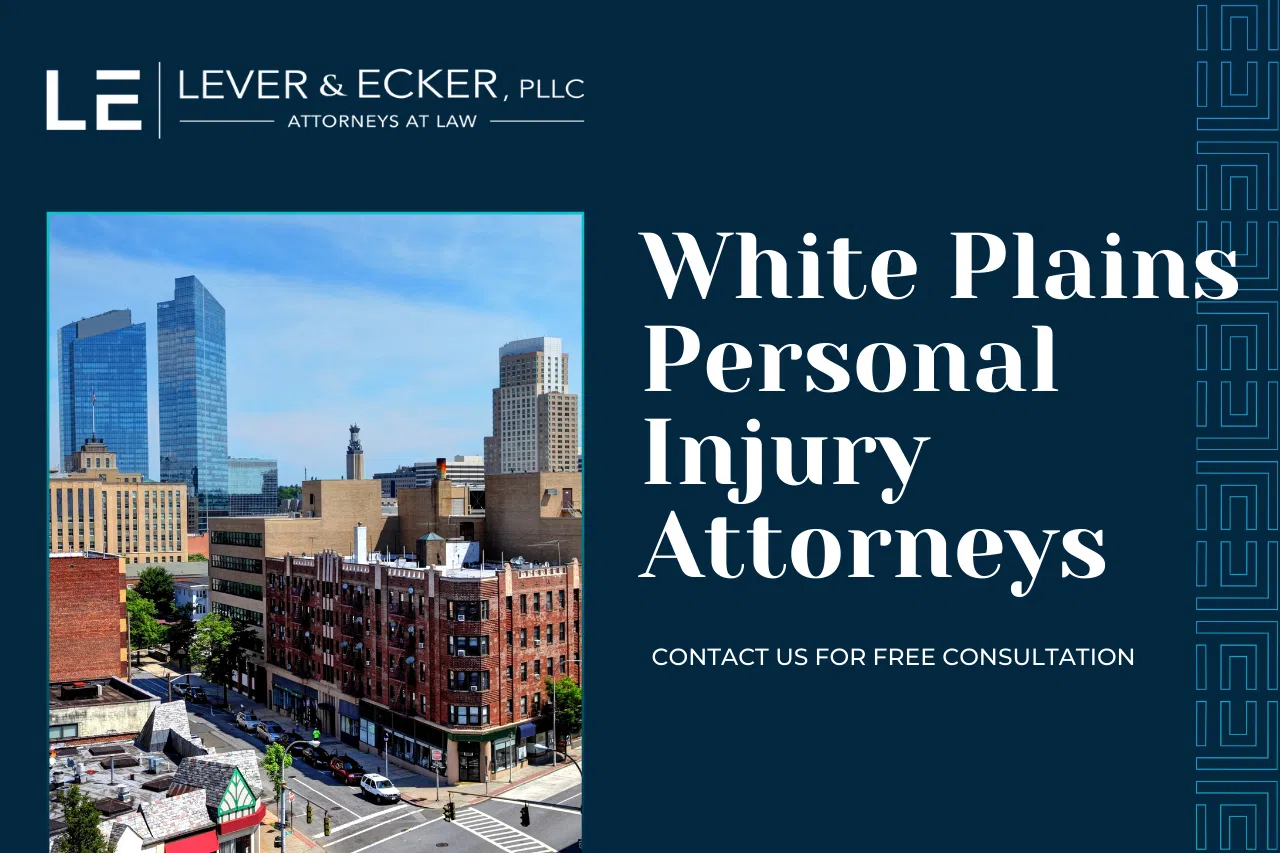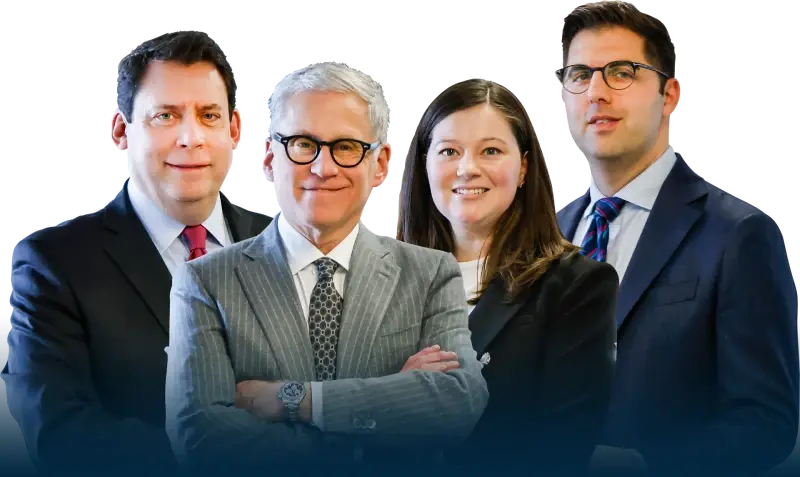White Plains Personal Injury Lawyer
If you’ve been injured in an accident, the physical, emotional, and financial toll can feel overwhelming. Lever & Ecker, PLLC, brings over 70 years of combined experience to help you hold the responsible parties accountable and pursue the compensation you deserve.
Our award-winning Westchester County personal injury attorneys have successfully represented countless victims in and around White Plains, NY. Call us today at (914) 288-9191 for a free consultation to discuss your case and how we can help.

Home ■ Personal Injury Lawyers in White Plains, NY

Key Takeaways
- In New York, you generally have three years to file a personal injury lawsuit, but some cases, like medical malpractice or claims against the city, have shorter deadlines. Missing these deadlines can mean losing your chance to get compensation.
- To win a personal injury case, you need to show that someone else was responsible for your injury and that it caused you harm. A good lawyer will gather the evidence, negotiate with insurance companies, and go to court if needed.
- If you’ve been injured, Lever & Ecker will help you pursue compensation for pain and suffering, medical bills, lost wages, and more. Our experienced personal injury attorneys will guide you through the process, ensuring you understand your rights and work to get you the full compensation you deserve.
Table of Contents
- Why Choose Our White Plains Injury Attorneys to Handle Your Case?
- Our Track Record of Success
- Our Award-Winning White Plains Attorneys
- Types of Injury Cases We Handle in White Plains
- How a Personal Injury Attorney Can Help Your Case Succeed
- How Long Do You Have to File a Personal Injury Lawsuit in White Plains?
- Contact our Award-Winning White Plains Personal Injury Lawyers Today
Why Choose Our White Plains Injury Attorneys to Handle Your Case?
Video Transcript
When we take on a new case for a client, our focus is on positioning their case in the best light possible. We ask ourselves what we need to do to maximize the recovery for the client and prepare the case for trial. By doing this, we send a clear message to insurance companies that we won’t simply accept their first offer. We examine the client’s case from every angle, because being shortsighted would mean not doing right by our clients. We pride ourselves on listening to our clients because it’s crucial for them to feel heard. I strive to treat my clients with the same respect I would expect if the roles were reversed. Our clients become an extension of our office family, and many of them have my cell phone number to reach me whenever they need.
Our practice is generally a boutique practice, meaning we handle no more than 25 to 30 cases per lawyer. This allows us to be proactive on each and every case. We do everything we can to make our clients whole, to the extent that money can achieve that. Success for us means not only getting maximum justice for our clients at the end of the case but also helping them navigate through a time when they are upside down physically and financially. The best case scenario for us is to secure a great settlement for our client and ensure they are set up for the future. We understand our role as lawyers, but we also strive to make things a little easier for our clients during what is often the most unbelievably tough situation in their lives.
Our White Plains personal injury firm has achieved a 99 percent success rate. Our approach is simple: We listen to you, guide you, and help you with what needs to be done right away. We take personal injury cases…very personally.
We limit the number of cases we take to provide exceptional service to every client. With client-centered representation and open lines of communication, we treat every case as the most important thing in our office. We work on a contingency fee basis, charging no upfront costs or fees. We don’t get paid unless and until we successfully resolve your case.
At Lever & Ecker, we understand that even simple cases can quickly become complex, and our attorneys will handle the legal process and deal with any challenges along the way. When we represent you, you can count on us to do the following:
- Provide 24/7 availability so you can discuss the details of your case whenever you need to.
- Work with your schedule, including after-hours, weekends, home, and hospital visits.
- Find you the right doctor if you don’t know where to go and provide the resources you need to get the right care.
- Thoroughly investigate your accident.
- Obtain and analyze all the relevant evidence.
- Establish liability and damages.
- Negotiate for a settlement with insurance companies and the opposition.
- File suit and, if necessary, aggressively advocate for you at trial.
Our Track Record of Success
We’re proud to say our reputation speaks for itself. Many of our clients have been referred to us by prior clients, friends, family, and other attorneys. Our successful track record of securing settlements for accident victims has resulted in over $250 million in total compensation for our clients, including the settlements below.
$12 million
$8.8 million
$3.48 million
for a pedestrian knockdown that caused significant lower leg injuries.
$3 million
settlement with a major metropolitan hospital that failed to diagnose our client’s cancer
$2.8 million
$2.15 million
$2 million
We Are 99% Successful in the Cases We Handle for Injury Victims
Contact us today to see if you have a case.
Our Award-Winning White Plains Attorneys
Our firm has over 70 years of combined experience handling all types of personal injury cases. We’re motivated by helping people and making a difference for our clients during the most difficult times. If you’ve been injured in an accident, attorneys David B. Lever, Daniel G. Ecker, Adam C. Weiss, and Katherine A. Henderson will provide top-tier representation.

David B. Lever, Founding Partner
Read Bio
Since 1990, David has advocated for the legal rights of accident victims and has never represented insurance companies or corporate defendants. Over the years, David has consistently recovered significant monetary awards for thousands of clients, including a $12 million settlement over a catastrophic motor vehicle collision. He can empathize with our clients by recalling his own motorcycle accident, which left him needing extensive medical treatment.
David has been selected for the New York Metro “Super Lawyers” list every year from 2020 through 2024, recognizing him as among the top five percent of plaintiff’s personal injury lawyers in the New York metro area. Additionally, he has been named one of the top 100 civil plaintiff trial lawyers in New York by the National Trial Lawyers organization and was named a Hudson Valley Top Lawyer in 2023 and 2024.

Daniel G. Ecker, Founding Partner
Read Bio
Daniel represents clients with passion and skill, treating them like family. Clients speak of his “guidance every step of the way” and how they were “treated with the utmost care and professionalism” throughout the legal process. Dan has overseen several of the firm’s largest recoveries, including a recent settlement of $8.8 million for a client who suffered severe injuries following a fall in a parking facility.
Dan has been named to the New York Metro “Super Lawyers” list every year from 2019 through 2024 and was named a Hudson Valley Top Lawyer in 2023 and 2024, as well as winning the New York State Bar Association Trial Lawyers Section’s Exceptional Contributions Award in 2015.

Adam C. Weiss, Partner
Read Bio
Adam has dedicated his career to representing injured plaintiffs and working to bring clients justice. He strives to uncover what really happened in every case and recover the maximum possible monetary compensation for his clients, keeping them informed and educated throughout the entire litigation process.
Throughout his career, Adam has recovered several multimillion-dollar settlements for medical malpractice and negligence claims and has litigated hundreds of birth injury cases. He has been named a New York Metro “Super Lawyers” Rising Star from 2020 through 2024, a Hudson Valley Top Lawyer from 2021 through 2024, and a National Trial Lawyers Top 40 Under 40 Civil Plaintiff Trial Lawyers in New York from 2020 through 2023.

Katherine A. Henderson, Associate Attorney
Read Bio
Katherine initially joined our firm as a law student intern, developing a passion for serving personal injury clients. She continued working with the firm throughout the remainder of law school and then joined the firm as a full-time associate in August 2022. She is passionate about helping others and has learned from some of the best in the field.
Types of Injury Cases We Handle in White Plains
At Lever & Ecker, our personal injury lawyers have extensive experience representing clients in all types of personal injury cases. If another party’s negligence caused you to suffer, we are committed to securing proper compensation for your injuries. With our proven approach and track record of success, we can handle many types of accident cases, including the following:
- Car Accidents
- Pedestrian Accidents
- Bicycle accidents
- Construction Accidents
- Slip, Trip & Fall Accidents
- Medical Malpractice
- Motorcycle Accidents
- Nursing home abuse and negligence
- Product liability claims
- Ridesharing accidents
- Traumatic brain injuries
- Workplace injuries
- Accidents causing wrongful death
- Truck Accidents
We Guide Every One Of Our Clients Through The Legal Process.
We'll take care of the hard work for you.
How a White Plains Injury Attorney Can Help Your Case Succeed
After an accident, we understand that physical injuries, emotional trauma, and financial loss may have forever changed your life. An attorney can pursue the compensation and damages you deserve after a negligent party harms you. We provide top-notch legal representation to resolve your claim as favorably as possible without compromising your legal rights. Of course, we can’t guarantee an outcome, but we will commit our time and resources to your case to give you the best possible chance of success.
To succeed in a personal injury claim, you must present evidence establishing a duty of care, a breach of that duty, causation, and quantifiable damages. Our experienced personal injury attorneys will work hard to establish and prove all these elements to pursue the compensation you deserve for your injuries.
We have the resources, experience, knowledge, and tools necessary to negotiate with insurance adjusters on your behalf so you don’t settle for less than you deserve. Insurance companies don’t play fair. We level the playing field. And we are always prepared to proceed to trial if the circumstances call for it.
How Long Do You Have to File a Personal Injury Lawsuit in White Plains?
Video Transcript
In the state of New York, there are statutes of limitations, which set a specific time frame within which a person must bring a claim. If the claim is not filed within this period, no matter how meritorious, the right to bring the claim is lost forever. Generally, for car crashes, the statute of limitations in New York is three years from the date of the incident. However, there are cases where the statute of limitations is shorter, such as when someone is struck by a city bus, involved in a subway crash, or in a collision with a vehicle owned by the state. When dealing with a municipality, whether it’s a city, state, town, or even the federal government, a notice of claim or, in certain cases, a notice of intention to make a claim, must be filed in writing within 90 days of the accident. My advice is that if you’ve been in an accident, you should contact our office immediately, as every case is different, and it would be unfortunate to miss your opportunity to bring a valid claim simply because you waited too long.
Generally, the statute of limitations for personal injury in New York is three years from the date of the incident, though that deadline can vary – and, in fact, be far shorter – in certain situations. Most personal injury and product liability cases must be filed within three years, most medical malpractice cases must be filed within two and a half years, and most wrongful death cases must be filed within two years. Cases against municipalities generally must be filed within one year and 90 days, and a document called a Notice of Claim must generally be submitted within just 90 days after the subject incident.
If you’ve been injured by someone else’s actions or negligence in White Plains, you have a limited time to file a lawsuit. It’s important to contact an attorney as soon as possible after an accident to ensure you comply with New York’s statutes of limitations for personal injury cases. Statutes of limitations impose strict deadlines for filing suit after an accident or injury. A personal injury attorney can confirm the applicable deadline or deadlines to file your case and ensure you seek damages in a timely manner. If you miss the filing deadline, the court will likely dismiss your case, and you will forever lose the right to recover the compensation you deserve.
Don't Run Out Of Time To File a Personal Injury Lawsuit.
We make sure everything for your lawsuit is filed on time.
Contact our Award-Winning White Plains Personal Injury Lawyers Today
Suffering injuries due to someone else’s negligence may leave you feeling vulnerable and overwhelmed, dealing with physical injuries, medical expenses, and emotional suffering. With an experienced personal injury lawyer from Lever & Ecker on your side, you aren’t alone.
From the minute you contact us until your case is resolved, we are committed to protecting your rights and holding responsible parties accountable. We treat our clients like family, not numbers.
Contact our White Plains personal injury attorneys today for a free consultation and case review by calling 914-288-9191 or filling out our online form.
"*" indicates required fields
"*" indicates required fields

